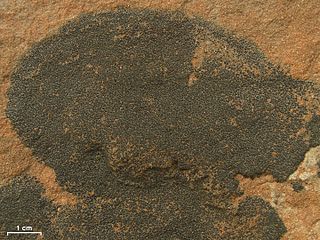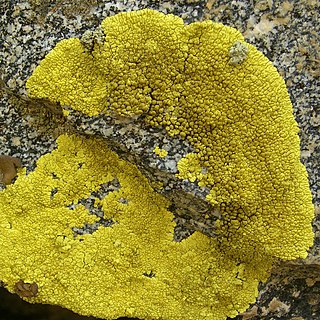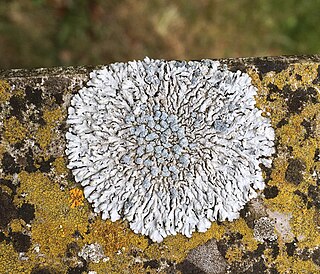
A lichen is a composite organism that arises from algae or cyanobacteria living among filaments of multiple fungi species in a mutualistic relationship. Lichens are important actors in nutrient cycling and act as producers which many higher trophic feeders feed on, such as reindeer, gastropods, nematodes, mites, and springtails. Lichens have properties different from those of their component organisms. They come in many colors, sizes, and forms and are sometimes plant-like, but are not plants. They may have tiny, leafless branches (fruticose); flat leaf-like structures (foliose); grow crust-like, adhering tightly to a surface (substrate) like a thick coat of paint (crustose); have a powder-like appearance (leprose); or other growth forms.

The ecology of the Sierra Nevada, located in the U.S. states of California and Nevada, is diverse and complex. The combination of climate, topography, moisture, and soils influences the distribution of ecological communities across an elevation gradient from 500 to 14,500 feet. Biotic zones range from scrub and chaparral communities at lower elevations, to subalpine forests and alpine meadows at the higher elevations. Particular ecoregions that follow elevation contours are often described as a series of belts that follow the length of the Sierra Nevada. There are many hiking trails, paved and unpaved roads, and vast public lands in the Sierra Nevada for exploring the many different biomes and ecosystems.

Ethnolichenology is the study of the relationship between lichens and people. Lichens have and are being used for many different purposes by human cultures across the world. The most common human use of lichens is for dye, but they have also been used for medicine, food and other purposes.

Bryoria fremontii is a dark brown, horsehair lichen that grows hanging from trees in western North America, and northern Europe and Asia. It grows abundantly in some areas, and is an important traditional food for a few First Nations in North America.

Vulpinic acid is a natural product first found in and important in the symbiosis underlying the biology of lichens. It is a simple methyl ester derivative of its parent compound, pulvinic acid, and a close relative of pulvinone, both of which derive from aromatic amino acids such as phenylalanine via secondary metabolism. The roles of vulpinic acid are not fully established, but may include properties that make it an antifeedant for herbivores. The compound is relatively toxic to mammals.

Letharia vulpina, commonly known as the wolf lichen, is a fruticose lichenized species of fungus in the family Parmeliaceae. It is bright yellow-green, shrubby and highly branched, and grows on the bark of living and dead conifers in parts of western and continental Europe and the Pacific Northwest and northern Rocky Mountains of North America. This species is somewhat toxic to mammals due to the yellow pigment vulpinic acid, and has been used historically as a poison for wolves and foxes. It has also been used traditionally by many native North American ethnic groups as a pigment source for dyes and paints.

Pilophorus acicularis, commonly known as the nail lichen or the devil's matchstick lichen, is a species of matchstick lichen in the family Cladoniaceae.

Lecidea atrobrunnea is a group of lichen-forming fungi in the family Lecideaceae. Previously though to represent a single, widely distributed crustose lichen, recent research has shown that the name represents many unique lineages of morphologically and chemically variable lichen-forming fungi that have not yet been precisely characterized. Members of this group are most diverse in mountains of the continental western United States and Alaska. With other lichen communities, it forms dark vertical drip-like stripings along drainage tracks in the rock faces, resulting in Native Americans giving the name "Face of a Young Woman Stained with Tears" to Half Dome. This combined lichen community appears black from a distance, but brown up close.

Staurothele areolata is blackish-brown crustose lichen in the family Verrucariaceae. It is found in western North America.

A fruticose lichen is a form of lichen fungi that is characterized by a coral-like shrubby or bushy growth structure. It is formed from a symbiotic relationship of a photobiont such as green algae or less commonly cyanobacteria and one, two or more mycobionts. Fruticose lichens are not a monophyletic and holophyletic lineage, but is a form encountered in many classes. Fruticose lichens have a complex vegetation structure, and are characterized by an ascending, bushy or pendulous appearance. As with other lichens, many fruticose lichens can endure high degrees of desiccation. They grow slowly and often occur in habitats such as on tree barks, on rock surfaces and on soils in the Arctic and mountain regions.

Crustose lichens are lichens that form a crust which strongly adheres to the substrate, making separation from the substrate impossible without destruction. The basic structure of crustose lichens consists of a cortex layer, an algal layer, and a medulla. The upper cortex layer is differentiated and is usually pigmented. The algal layer lies beneath the cortex. The medulla fastens the lichen to the substrate and is made up of fungal hyphae. The surface of crustose lichens is characterized by branching cracks that periodically close in response to climatic variations such as alternate wetting and drying regimes.

Lichens are symbiotic organisms made up of multiple species: a fungus, one or more photobionts and sometimes a yeast. They are regularly grouped by their external appearance – a characteristic known as their growth form. This form, which is based on the appearance of vegetative part of the lichen, varies depending on the species and the environmental conditions it faces. Those who study lichens (lichenologists) have described a dozen of these forms: areolate, byssoid, calicioid, cladoniform, crustose, filamentous, foliose, fruticose, gelatinous, leprose, placoidioid and squamulose. Traditionally, crustose (flat), foliose (leafy) and fruticose (shrubby) are considered to be the three main forms. In addition to these more formalised, traditional growth types, there are a handful of informal types named for their resemblance to the lichens of specific genera. These include alectorioid, catapyrenioid, cetrarioid, hypogymnioid, parmelioid and usneoid.

Pleopsidium flavum is a distinctively colored, bright lemon-yellow to chartreuse crustose lichen that grows in high elevations on vertical or overhanging hard felsic rock in western North America. Its thallus grows in a circular outwardly radiating pattern (placodioid), with 1mm wide lobed edges. This is the identity of the vivid, lime-green lichens often photographed on granite boulders in the Wichita Mountains Wildlife Refuge of Oklahoma. According to Prof. Wayne Armstrong of Mount Palomar College, This lichen only grows "a few millimeters" per century., making it the slowest growing of all known plants.
Lepraria pacifica, the Pacific dust lichen, is a whitish-blue-green leprose crustose lichen that grows on its substrate like patches of granular, caked-up, mealy dust grains. Like other members of the Lepraria genus, it only reproduces asexually.

Physcia caesia, known colloquially as blue-gray rosette lichen and powder-back lichen, is a species of foliose lichenized fungus. First described by Georg Franz Hoffmann in 1784, it is common across much of Europe, North America and New Zealand, and more patchily distributed in South America, Asia, Australia and Antarctica. There are 2 subspecies: P. c. caesia and P. c. ventosa, as well as a number of distinct forms and varieties. Molecular studies suggest that the species as currently defined may be polyphyletic. It is typically pale gray shading to darker gray in the center, and grows in a small rosette, usually some 2–3 cm (0.79–1.18 in) across at maturity. It only rarely has apothecia, instead reproducing most often vegetatively via soredia, which are piled in round blue-gray mounds across the thallus's upper surface. It grows most often on rock—principally calcareous, but also basaltic and siliceous—and also occurs on bone, bark and soil. It is nitrophilic and is particularly common on substrates where birds perch.
Some types of lichen are able to fix nitrogen from the atmosphere. This process relies on the presence of cyanobacteria as a partner species within the lichen. The ability to fix nitrogen enables lichen to live in nutrient-poor environments. Lichen can also extract nitrogen from the rocks on which they grow.

Calicium trabinellum, commonly known as the yellow-collar stubble lichen, is a widespread species of pin lichen in the family Caliciaceae. It was first described by Swedish lichenologist Erik Acharius in 1803 as Calicium xylonellum ß trabinellum. He made the new combination Calicium trabinellum in a later chapter of the same publication.

Letharia columbiana is a common lichen in subalpine forests, particularly in the Pacific Northwest of the United States, and parts of Canada. It is in the family Parmeliaceae, and the genus Letharia. Its characteristics include a bright citron color, “brown-eyes”, and rounded, irregular branches. Though previously believed to lump together several lineages such as Letharia gracilis and others, there now exists more specific characteristics to identify the species. This lichen grows on the bark of conifers a couple inches tall. L. Columbiana’s cousin, Letharia vulpina (common name wolf lichen), has similar geographical distribution and morphological features, with the major difference being the “brown-eyes” of L. columbiana.
Heteroplacidium zamenhofianum is a species of lichenicolous (lichen-eating) lichen in the family Verrucariaceae. As a juvenile, it is parasitic on some members of the lichen genus Staurothele, but later becomes independent and develops a brown, crustose thallus. Characteristic features of the lichen include its dark brown, somewhat squamulous thallus and relatively small ascospores. It is widely distributed in Europe and North America.

Chrysothrix chlorina, the sulphur dust lichen, is a species of leprose (powdery) crustose lichen in the family Chrysotrichaceae. Originally described scientifically by the Swedish lichenologist Erik Acharius over 200 years ago, it has been shuffled to many different genera in its taxonomic history before finally being transferred to Chrysothrix in 1981. The lichen has a circumboreal distribution, meaning it occurs in northern boreal regions across the planet. It is typically saxicolous (rock-dwelling), particularly on the underside of rock overhangs, but has in rare instances been recorded growing on bark and various other surfaces.

















